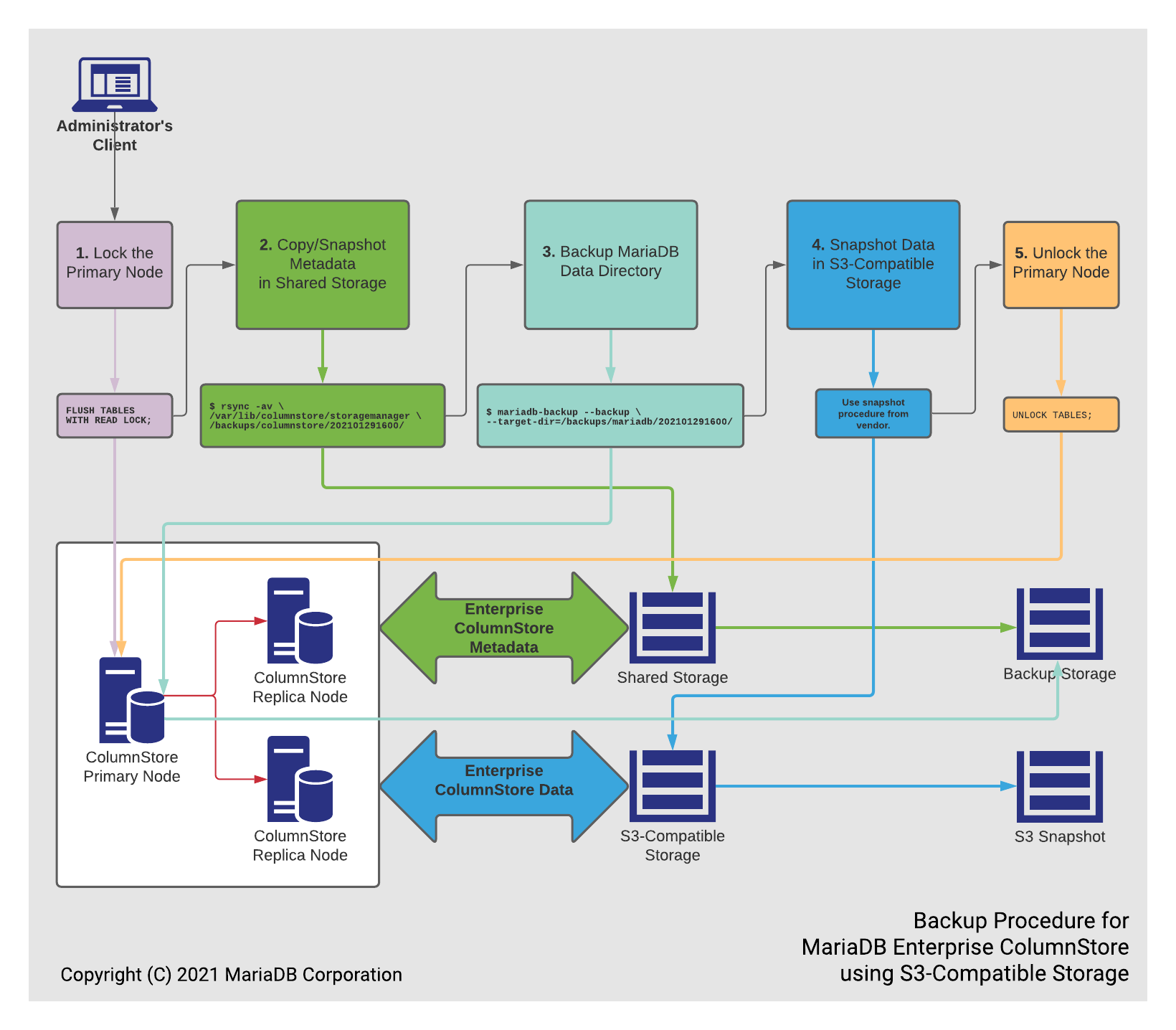MariaDB Enterprise ColumnStore Backup and Restore with Object Storage
This page is part of MariaDB's Documentation.
The parent of this page is: Backup and Restore with MariaDB Enterprise ColumnStore
Topics on this page:
Overview
MariaDB Enterprise ColumnStore supports backup and restore. If Enterprise ColumnStore uses S3-compatible object storage for data and shared local storage for the Storage Manager directory, the S3 bucket, the Storage Manager directory, and the MariaDB data directory must be backed up separately.
Recovery Planning
MariaDB Enterprise ColumnStore supports multiple storage options.
This page discusses how to backup and restore Enterprise ColumnStore when it uses S3-compatible object storage for data and shared local storage (such as NFS) for the Storage Manager directory.
Any file can become corrupt due to hardware issues, crashes, power loss, and other reasons. If the Enterprise ColumnStore data or metadata were to become corrupt, Enterprise ColumnStore could become unusable, and data loss could occur.
If Enterprise ColumnStore is your system of record, it should be backed up regularly.
If Enterprise ColumnStore uses S3-compatible object storage for data and shared local storage for the Storage Manager directory, the following items must be backed up:
The MariaDB Data directory is backed up using mariadb-backup
The S3 bucket must be backed up using the vendor's snapshot procedure
The Storage Manager directory must be backed up
See the instructions below for more details.
Backup
Use the following process to take a backup:
Determine which node is the primary server using
curlto send thestatuscommand to the CMAPI Server:$ curl -k -s https://mcs1:8640/cmapi/0.4.0/cluster/status \ --header 'Content-Type:application/json' \ --header 'x-api-key:93816fa66cc2d8c224e62275bd4f248234dd4947b68d4af2b29671dd7d5532dd' \ | jq .
The output will show
"dbrm_mode": "master"for the primary server:{ "timestamp": "2020-12-15 00:40:34.353574", "192.0.2.1": { "timestamp": "2020-12-15 00:40:34.362374", "uptime": 11467, "dbrm_mode": "master", "cluster_mode": "readwrite", "dbroots": [ "1" ], "module_id": 1, "services": [ { "name": "workernode", "pid": 19202 }, { "name": "controllernode", "pid": 19232 }, { "name": "PrimProc", "pid": 19254 }, { "name": "ExeMgr", "pid": 19292 }, { "name": "WriteEngine", "pid": 19316 }, { "name": "DMLProc", "pid": 19332 }, { "name": "DDLProc", "pid": 19366 } ] }
Connect to the primary server using MariaDB Client as a user account that has privileges to lock the database:
$ mariadb --host=192.0.2.1 \ --user=root \ --password
Lock the database with the FLUSH TABLES WITH READ LOCK statement:
FLUSH TABLES WITH READ LOCK;Ensure that the client remains connected to the primary server, so that the lock is held for the remaining steps.
Make a copy or snapshot of the Storage Manager directory. By default, it is located at
/var/lib/columnstore/storagemanager.For example, to make a copy of the directory with rsync:
$ sudo mkdir -p /backups/columnstore/202101291600/ $ sudo rsync -av /var/lib/columnstore/storagemanager /backups/columnstore/202101291600/
Use MariaDB Backup to backup the MariaDB data directory:
$ sudo mkdir -p /backups/mariadb/202101291600/ $ sudo mariadb-backup --backup \ --target-dir=/backups/mariadb/202101291600/ \ --user=mariabackup \ --password=mbu_passwd
Use MariaDB Backup to prepare the backup:
$ sudo mariadb-backup --prepare \ --target-dir=/backups/mariadb/202101291600/
Create a snapshot of the S3-compatible storage.
Consult the storage vendor's manual for details on how to do this.
Ensure that all previous operations are complete.
In the original client connection to the primary server, unlock the database with the UNLOCK TABLES statement:
UNLOCK TABLES;
Restore
Use the following process to restore a backup:
Deploy Enterprise ColumnStore, so that you can restore the backup to an empty deployment.
Ensure that all services are stopped on each node:
$ sudo systemctl stop mariadb-columnstore-cmapi $ sudo systemctl stop mariadb-columnstore $ sudo systemctl stop mariadb
Restore the backup of the Storage Manager directory. By default, it is located at
/var/lib/columnstore/storagemanager.For example, to restore the backup with rsync:
$ sudo rsync -av /backups/columnstore/202101291600/storagemanager/ /var/lib/columnstore/storagemanager/ $ sudo chown -R mysql:mysql /var/lib/columnstore/storagemanager
Use MariaDB Backup to restore the backup of the MariaDB data directory:
$ sudo mariadb-backup --copy-back \ --target-dir=/backups/mariadb/202101291600/ $ sudo chown -R mysql:mysql /var/lib/mysql
Restore the snapshot of your S3-compatible storage to the new S3 bucket that you plan to use.
Consult the storage vendor's manual for details on how to do this.
Update
storagemanager.cnfto configure Enterprise ColumnStore to use the S3 bucket. By default, it is located at/etc/columnstore/storagemanager.cnf.For example:
[ObjectStorage] … service = S3 … [S3] bucket = your_columnstore_bucket_name endpoint = your_s3_endpoint aws_access_key_id = your_s3_access_key_id aws_secret_access_key = your_s3_secret_key # iam_role_name = your_iam_role # sts_region = your_sts_region # sts_endpoint = your_sts_endpoint [Cache] cache_size = your_local_cache_size path = your_local_cache_path
The default local cache size is 2 GB.
The default local cache path is
/var/lib/columnstore/storagemanager/cache.Ensure that the local cache path has sufficient store space to store the local cache.
The
bucketoption must be set to the name of the bucket that you created from your snapshot in the previous step.To use an IAM role, you must also uncomment and set
iam_role_name,sts_region, andsts_endpoint.
Start the services on each node:
$ sudo systemctl start mariadb $ sudo systemctl start mariadb-columnstore-cmapi

